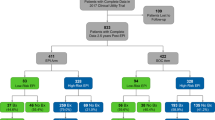Abstract
Prostatic crystalloids are intraluminal eosinophilic structures with variable size and shape. Their presence has been described in conjunction with the occurrence of prostatic adenocarcinoma (pCA). We herein report the association of crystalloids and pCA in a prospective trial utilizing an extended multi-site transrectal ultrasound-guided (TRUS) prostate biopsy protocol. Three hundred and forty-four consecutive patients were prospectively enrolled at the Dallas Veterans Administration Hospital from November 2002 to September 2003. Indications for biopsy included a prostate-specific antigen (PSA) ⩾4 ng/ml and/or abnormal digital rectal exam. A single pathologist evaluated all biopsy cores and documented the presence or absence of significant histopathologic features. Univariate and multivariate logistic regression analysis were applied to test the association of these features with the presence of pCA on concurrent biopsy. Median number of core biopsies per patient was 12 (range 3–36). Overall cancer detection rate was 42.7%. pCA was diagnosed in 66 (81.5%) of 81 patients with crystalloids, 70 (69.3%) of 101 patients with high-grade prostatic intraepithelial neoplasia (HGPIN), and 32 (84.2%) of 38 patients with both HGPIN and crystalloids on biopsy. Multivariate analysis identified crystalloids (RR 4.53, 95% CI 2.30–8.88) and HGPIN (RR 3.20, 95% CI 1.84–5.57) as independent predictors of the presence of cancer on concurrent biopsy (P<0.001). In this prospective analysis, crystalloids were significantly associated with pCA on concurrent biopsy and more predictive of the presence of pCA than HGPIN. These findings suggest that the presence of crystalloids alone or in combination with HGPIN in prostate biopsies may be a more compelling indication for repeat biopsy than HGPIN alone.
This is a preview of subscription content, access via your institution
Access options
Subscribe to this journal
Receive 4 print issues and online access
$259.00 per year
only $64.75 per issue
Buy this article
- Purchase on Springer Link
- Instant access to full article PDF
Prices may be subject to local taxes which are calculated during checkout

Similar content being viewed by others
References
Ro JY, Ngadiman S, Sahin A, Sneige N, Ordonez NG, Cartwright Jr J et al. Intraluminal crystalloids in breast carcinoma. Immunohistochemical, ultrastructural, and energy-dispersive x-ray element analysis in four cases. Arch Pathol Lab Med 1997; 121: 593–598.
Ro JY, Grignon DJ, Troncoso P, Ayala AG . Intraluminal crystalloids in whole-organ sections of prostate. Prostate 1988; 13: 233–239.
Ro JY, Ayala AG, Ordonez NG, Cartwright Jr J, Mackay B . Intraluminal crystalloids in prostatic adenocarcinoma. Immunohistochemical, electron microscopic, and x-ray microanalytic studies. Cancer 1986; 57: 2397–2407.
Jensen PE, Gardner Jr WA, Piserchia PV . Prostatic crystalloids: association with adenocarcinoma. Prostate 1980; 1: 25–30.
Gore JL, Shariat SF, Miles BJ, Kadmon D, Jiang N, Wheeler TM et al. Optimal combinations of systematic sextant and laterally directed biopsies for the detection of prostate cancer. J Urol 2001; 165: 1554.
Chon CH, Lai FC, McNeal JE, Presti Jr JC . Use of extended systematic sampling in patients with a prior negative prostate needle biopsy. J Urol 2002; 167: 2457.
Mian BM, Naya Y, Okihara K, Vakar-Lopez F, Troncoso P, Babaian RJ . Predictors of cancer in repeat extended multisite prostate biopsy in men with previous negative extended multisite biopsy. Urology 2002; 60: 836–840.
Singh H, Canto EI, Shariat SF, Kadmon D, Miles BJ, Wheeler TM et al. Predictors of prostate cancer after initial negative systematic 12 core biopsy. J Urol 2004; 171: 1850–1854.
Holmes EJ . Crystalloids of prostatic carcinoma: relationship to Bence–Jones crystals. Cancer 1977; 39: 2073–2080.
Furusato M, Kato H, Takahashi H, Wakui S, Tokuda T, Kawashima Y et al. Crystalloids in latent prostatic carcinoma. Prostate 1989; 15: 259–262.
Henneberry JM, Kahane H, Humphrey PA, Keetch DW, Epstein JI . The significance of intraluminal crystalloids in benign prostatic glands on needle biopsy. Am J Surg Pathol 1997; 21: 725–728.
Anton RC, Chakraborty S, Wheeler TM . The significance of intraluminal prostatic crystalloids in benign needle biopsies. Am J Surg Pathol 1998; 22: 446–449.
Naya Y, Ayala AG, Tamboli P, Babaian RJ . Can the number of cores with high-grade prostate intraepithelial neoplasia predict cancer in men who undergo repeat biopsy? Urology 2004; 63: 503–508.
Bostwick DG, Amin MB, Dundore P, Marsh W, Schultz DS . Architectural patterns of high-grade prostatic intraepithelial neoplasia. Hum Pathol 1993; 24: 298–310.
Kronz JD, Shaikh AA, Epstein JI . High-grade prostatic intraepithelial neoplasia with adjacent small atypical glands on prostate biopsy. Hum Pathol 2001; 32: 389–395.
Brawer MK, Bigler SA, Sohlberg OE, Nagle RB, Lange PH . Significance of prostatic intraepithelial neoplasia on prostate needle biopsy. Urology 1991; 38: 103–107.
Davidson D, Bostwick DG, Qian J, Wollan PC, Oesterling JE, Rudders RA et al. Prostatic intraepithelial neoplasia is a risk factor for adenocarcinoma: predictive accuracy in needle biopsies. J Urol 1995; 154: 1295–1299.
Markham CW . Prostatic intraepithelial neoplasia: detection and correlation with invasive cancer in fine-needle biopsy. Urology 1989; 34: 57–61.
Varma M, Lee MW, Tamboli P, Zarbo RJ, Jimenez RE, Salles PG et al. Morphologic criteria for the diagnosis of prostatic adenocarcinoma in needle biopsy specimens. A study of 250 consecutive cases in a routine surgical pathology practice. Arch Pathol Lab Med 2002; 126: 554–561.
Allam CK, Bostwick DG, Hayes JA, Upton MP, Wade GG, Domanowski GF et al. Interobserver variability in the diagnosis of high-grade prostatic intraepithelial neoplasia and adenocarcinoma. Mod Pathol 1996; 9: 742–751.
Author information
Authors and Affiliations
Corresponding author
Additional information
This data was partly presented at the AUA meeting in 2004.
Rights and permissions
About this article
Cite this article
Svatek, R., Karam, J., Rogers, T. et al. Intraluminal crystalloids are highly associated with prostatic adenocarcinoma on concurrent biopsy specimens. Prostate Cancer Prostatic Dis 10, 279–282 (2007). https://doi.org/10.1038/sj.pcan.4500954
Received:
Revised:
Accepted:
Published:
Issue Date:
DOI: https://doi.org/10.1038/sj.pcan.4500954



